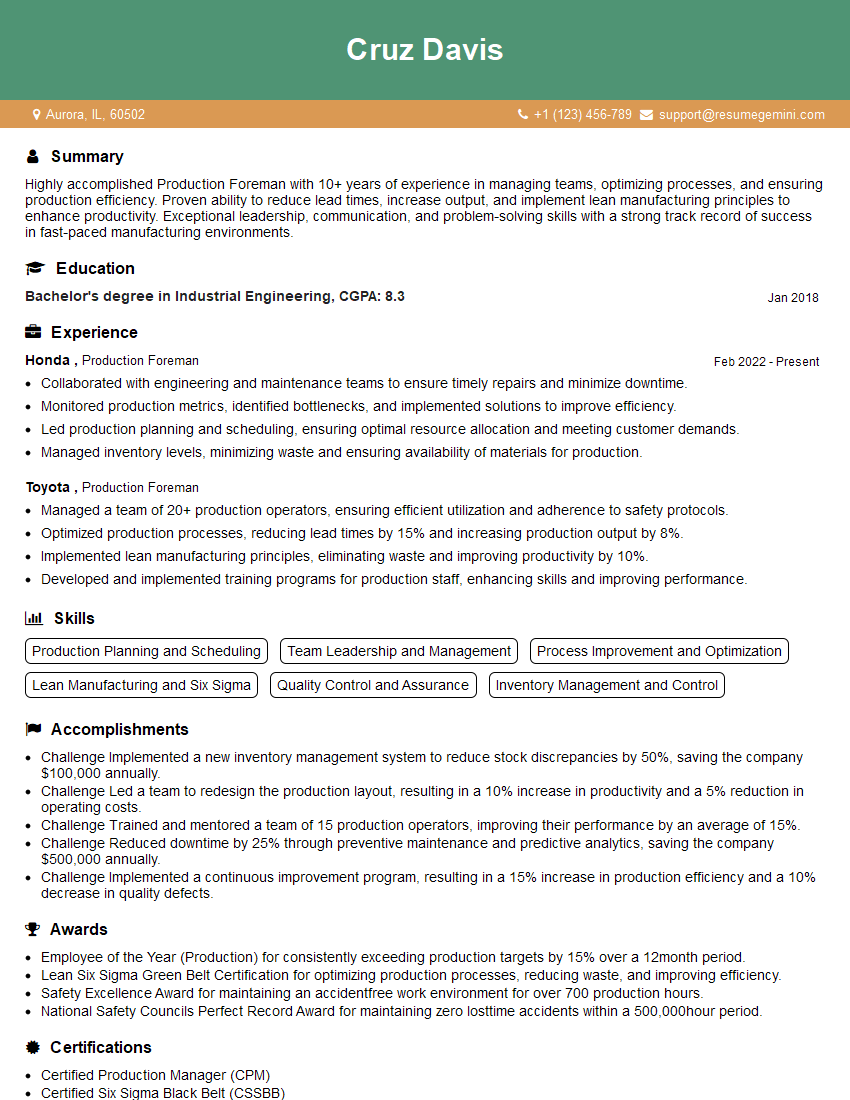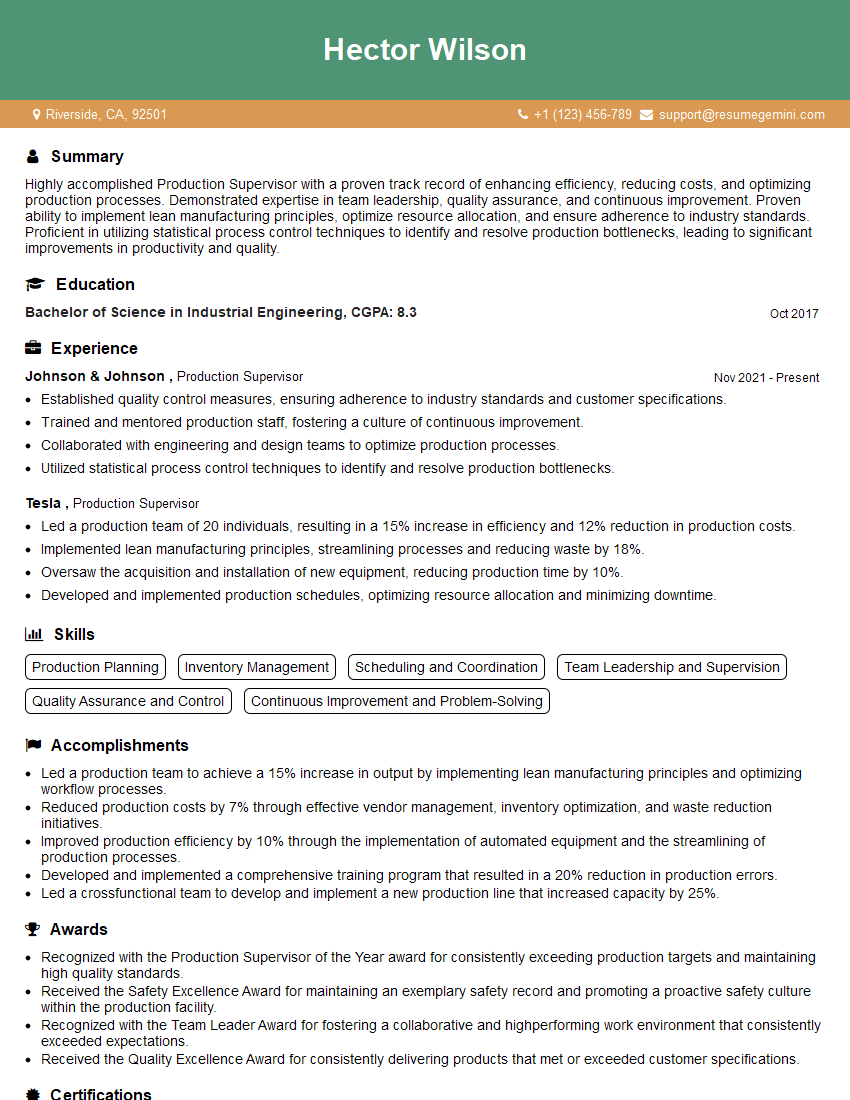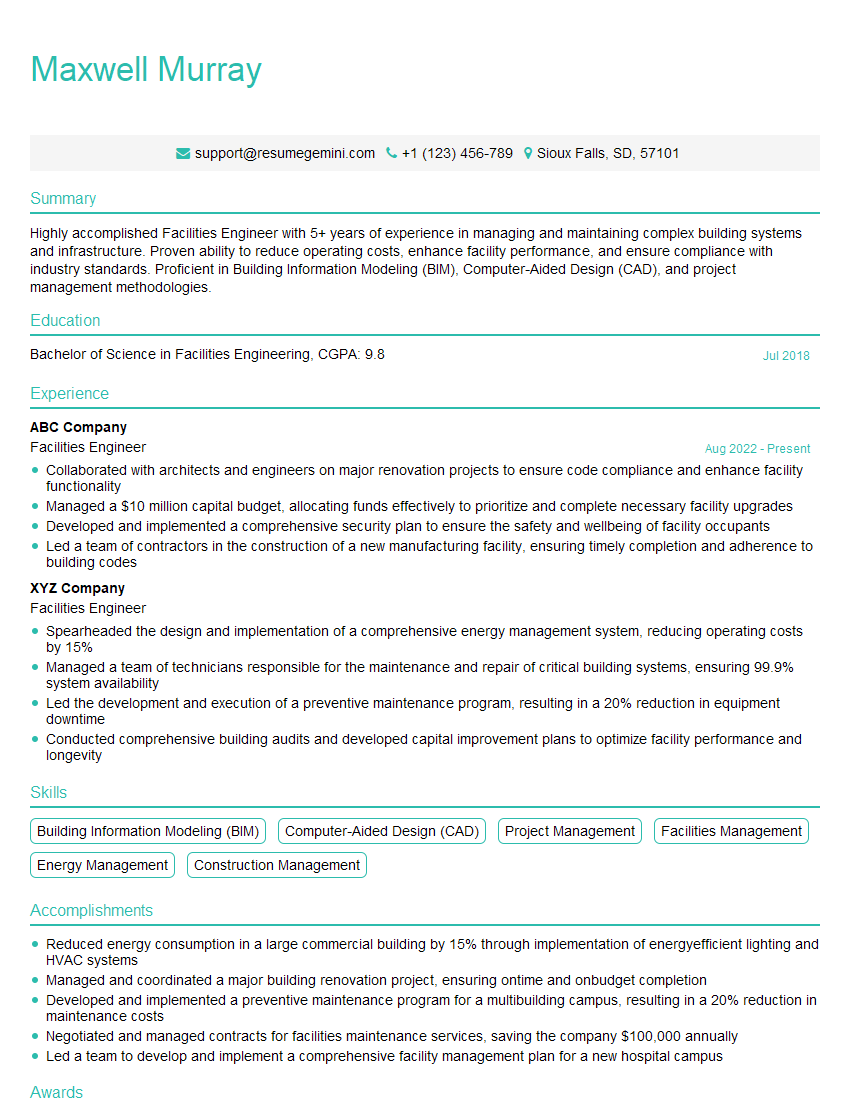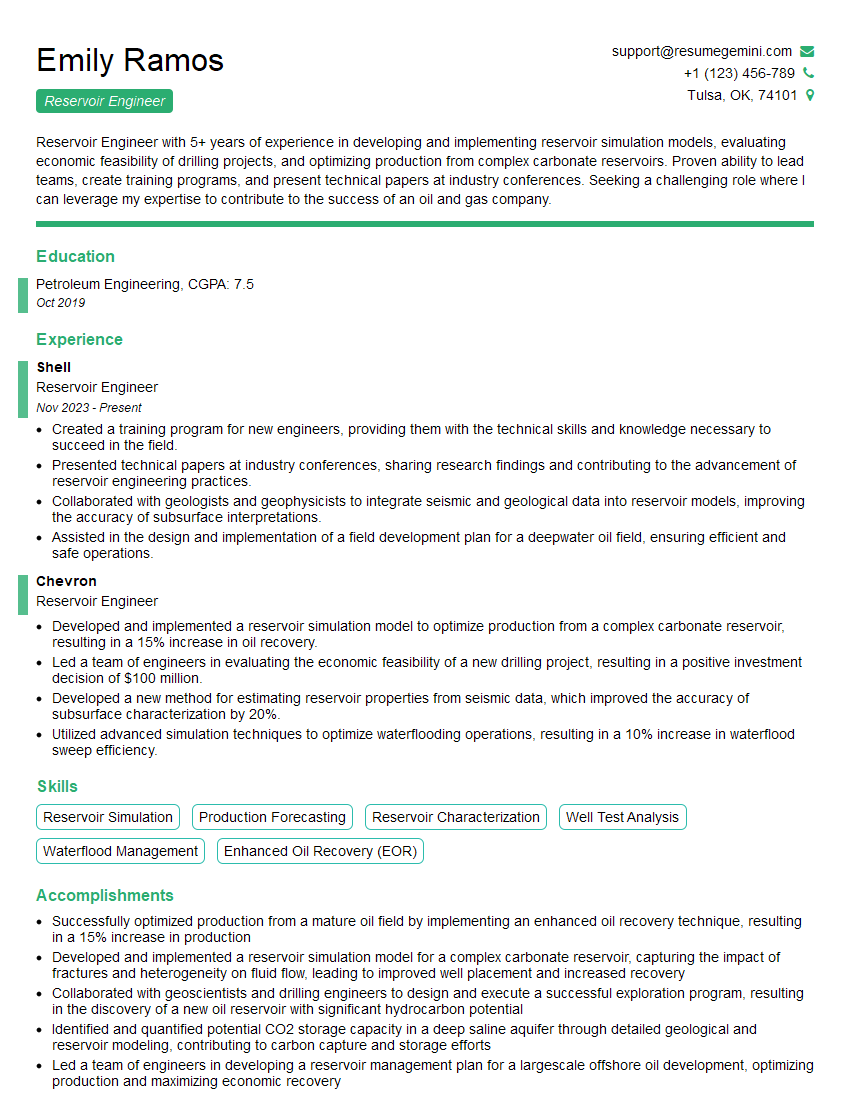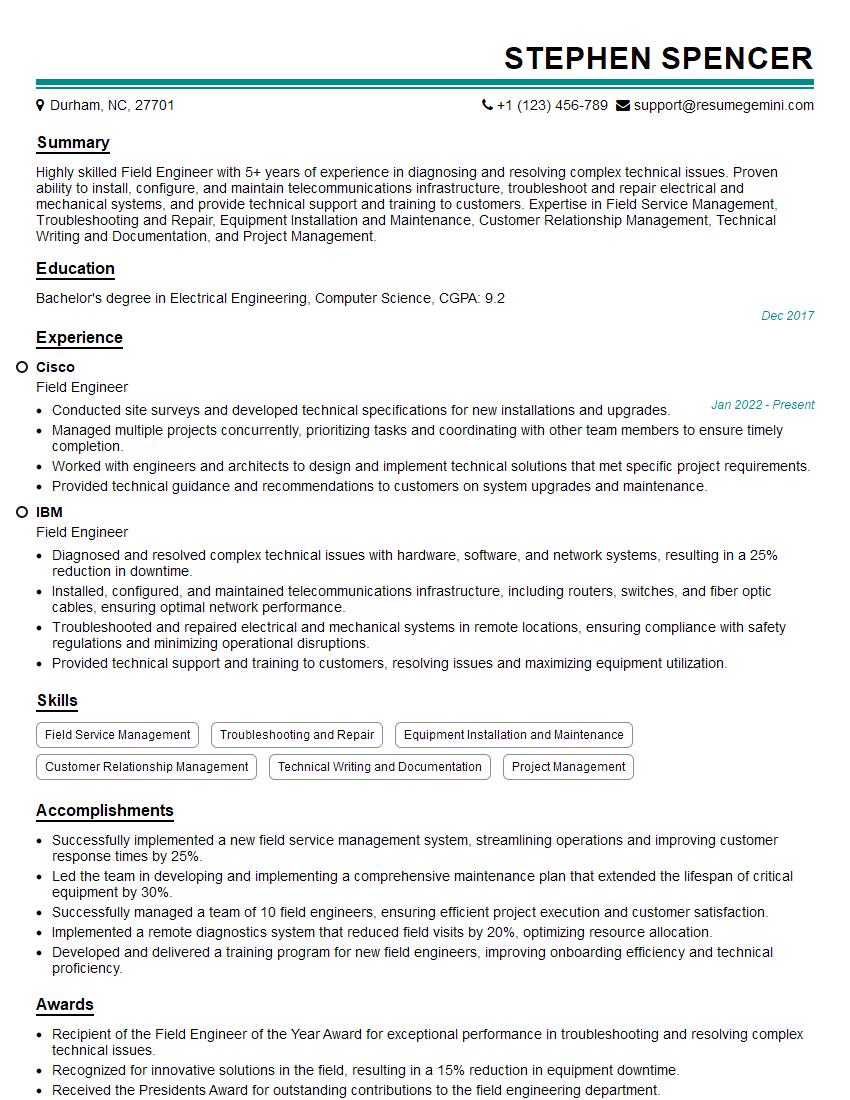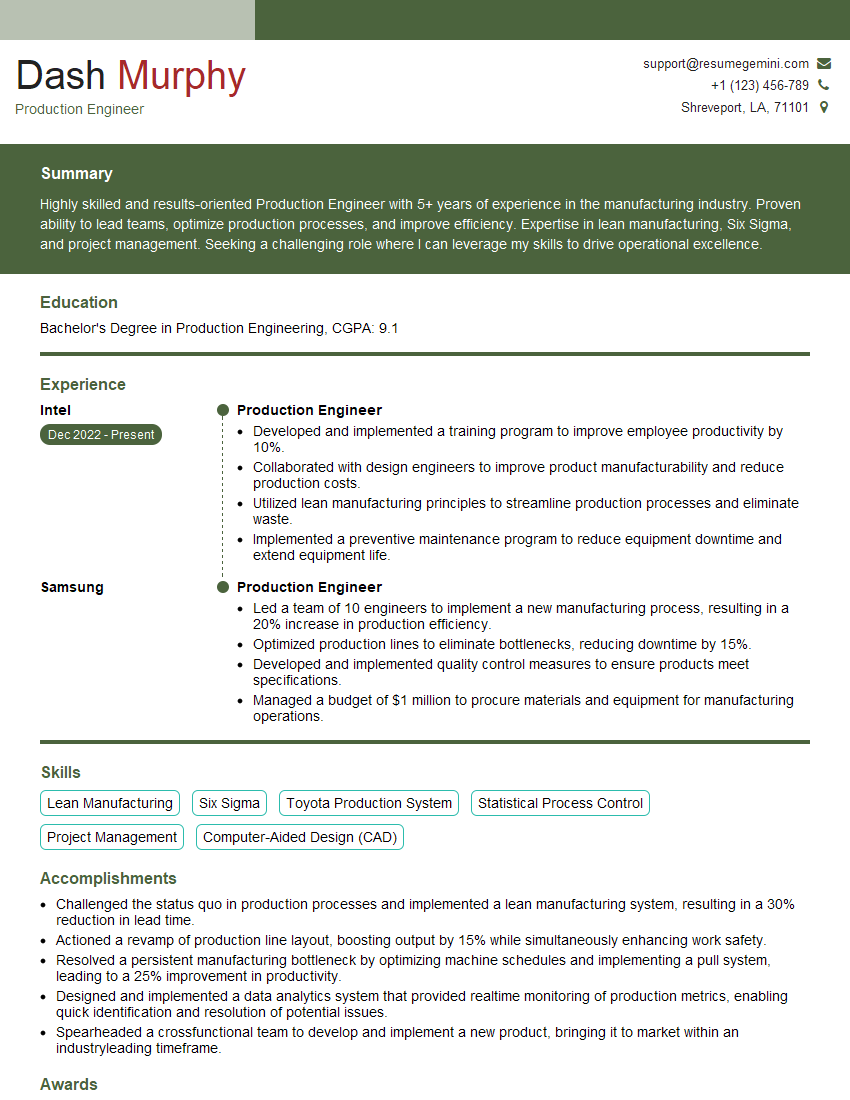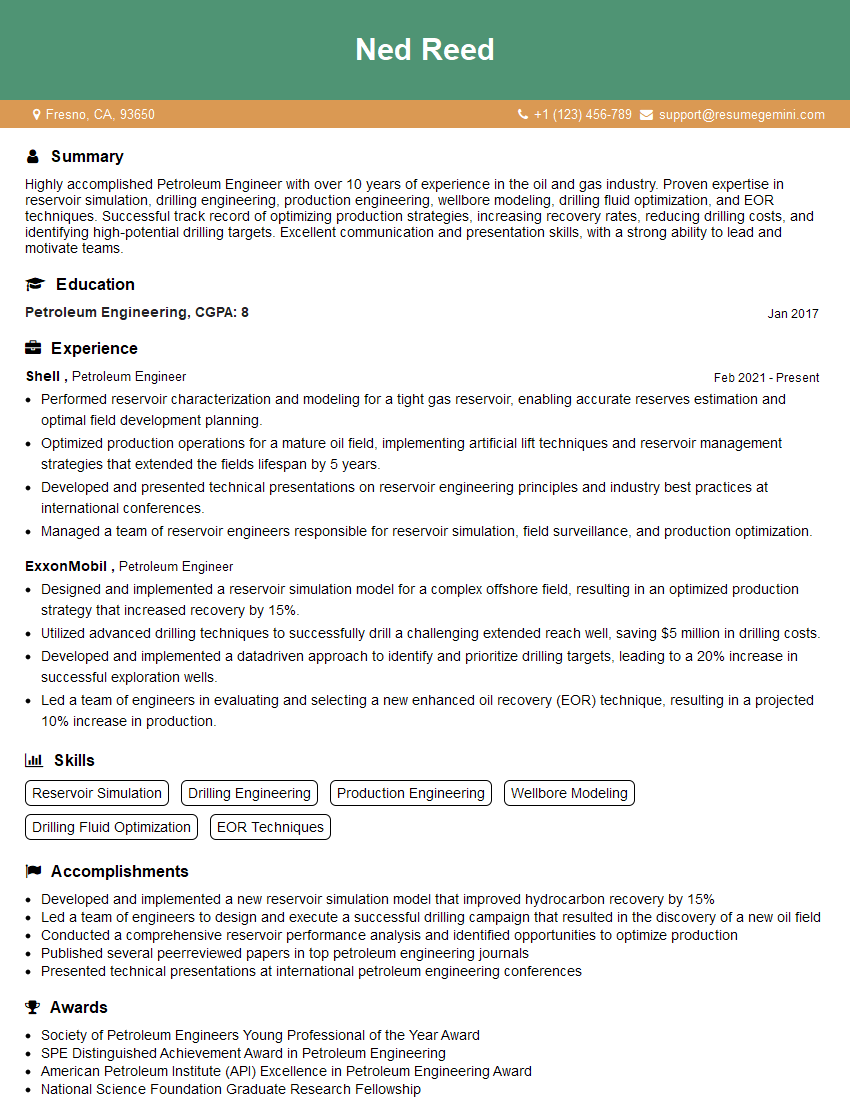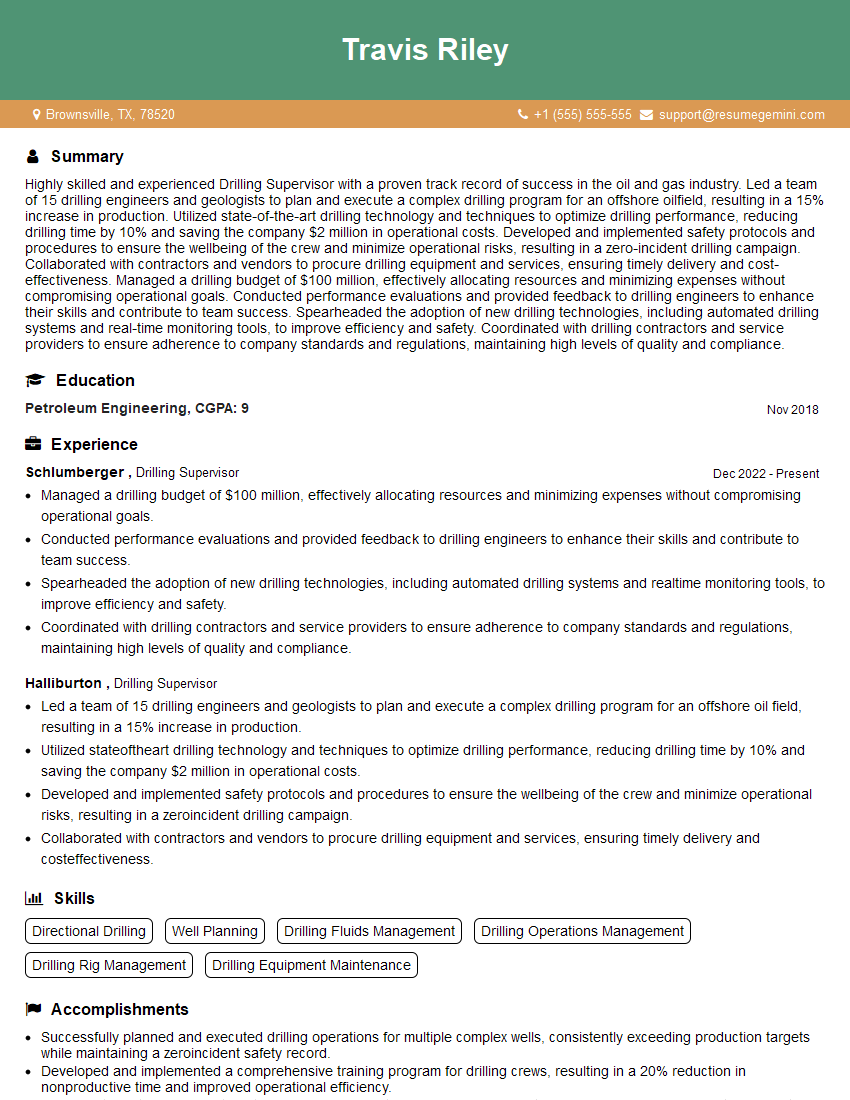Interviews are more than just a Q&A session—they’re a chance to prove your worth. This blog dives into essential Oil and Gas Production Knowledge interview questions and expert tips to help you align your answers with what hiring managers are looking for. Start preparing to shine!
Questions Asked in Oil and Gas Production Knowledge Interview
Q 1. Explain the difference between primary, secondary, and tertiary oil recovery methods.
Oil recovery methods are categorized into primary, secondary, and tertiary, each representing a stage in extracting hydrocarbons from a reservoir. Think of it like squeezing a sponge: primary is the initial squeeze, secondary adds more pressure, and tertiary uses advanced techniques to get the last drops.
- Primary Recovery: This is the natural drive mechanism. Reservoir pressure naturally pushes oil towards the wellbore. It’s the simplest method, relying on the initial reservoir energy (e.g., gas expansion, water drive). Typically, only around 10-15% of the original oil in place (OOIP) is recovered this way. Imagine a water-filled balloon. The water’s natural pressure pushes out the contained air.
- Secondary Recovery: Once the natural reservoir pressure declines, secondary methods are employed to enhance oil extraction. These techniques involve artificially increasing the reservoir pressure to displace more oil towards the producing wells. Common methods include waterflooding (injecting water to push oil) and gas injection (injecting gas to maintain reservoir pressure). This can increase recovery to 30-40% of OOIP. Think of squeezing the balloon harder with your hand.
- Tertiary Recovery (Enhanced Oil Recovery or EOR): This involves advanced techniques to further increase oil recovery beyond secondary methods. These methods aim to improve the oil’s mobility in the reservoir. EOR methods include chemical flooding (injecting polymers or surfactants to reduce water viscosity and improve oil mobility), thermal recovery (injecting steam or hot water to reduce oil viscosity), and miscible displacement (injecting gases that mix with oil to improve its flow). EOR can increase recovery to 50% or more of OOIP, depending on the reservoir characteristics and the effectiveness of the EOR technique. This is like using a special solvent to dissolve the last bit of oil from the sponge.
Q 2. Describe your experience with artificial lift techniques (e.g., ESP, gas lift).
I have extensive experience with various artificial lift techniques, particularly Electrical Submersible Pumps (ESPs) and gas lift. My experience spans design, installation, troubleshooting, and optimization across diverse well conditions.
- ESPs: I’ve overseen the selection, installation, and performance monitoring of ESPs in high-water-cut wells. We utilize advanced diagnostics and predictive modeling to optimize ESP performance and minimize downtime. For instance, on a project in the North Sea, we implemented a remote monitoring system for ESPs, enabling proactive maintenance and significantly reducing operational costs. We identified recurring issues with sand erosion by analyzing pump performance data, and adjusted the sand control strategy, leading to a 20% increase in production.
- Gas Lift: I’ve worked extensively on gas lift systems, including designing efficient gas injection strategies to optimize lift performance and minimize gas-oil ratios. In a project involving a challenging high-pressure gas reservoir, we developed a customized gas lift system using advanced simulations to account for the unique reservoir characteristics and optimize injection points. This resulted in a substantial increase in production and improved well profitability.
My experience includes troubleshooting and resolving operational issues. A particularly challenging case involved a malfunctioning ESP in a deepwater well. Through systematic diagnostics and data analysis, we pinpointed the problem to a faulty power cable and successfully completed a remotely operated vehicle (ROV) intervention for repair, limiting production downtime.
Q 3. How do you monitor and optimize production from a well?
Monitoring and optimizing well production is a continuous process requiring a multi-faceted approach. It’s crucial to closely track key parameters to ensure efficient and sustainable production.
- Real-time Data Acquisition: We utilize SCADA (Supervisory Control and Data Acquisition) systems to gather real-time data on production rates (oil, water, gas), pressure, temperature, and other relevant parameters. This data allows for immediate detection of anomalies and potential issues.
- Data Analysis and Interpretation: We employ advanced data analytics techniques to identify trends, anomalies, and potential bottlenecks. This may involve analyzing production profiles, reservoir simulation outputs, and other relevant data to diagnose problems and optimize well performance.
- Well Testing: Periodic well testing, such as production logging, is crucial for assessing reservoir conditions, identifying fluid distribution, and determining the health of the well. This helps to pinpoint areas for improvement.
- Optimization Strategies: Based on the analyzed data, we implement appropriate optimization strategies. This may involve adjusting production parameters, implementing improved artificial lift systems, or conducting reservoir stimulation operations to enhance productivity.
For example, by analyzing real-time production data, we identified a sudden decline in oil production from a specific well. Through further investigation, we found a build-up of scale in the wellbore. We promptly initiated a scale removal operation which fully restored the well’s production capacity.
Q 4. What are the key performance indicators (KPIs) used to assess production efficiency?
Key Performance Indicators (KPIs) are essential for measuring the efficiency and profitability of oil and gas production. They provide insights into operational effectiveness and areas for improvement. These KPIs are often used in conjunction with each other for a holistic view.
- Oil Production Rate (OPR): The volume of oil produced per unit time (e.g., barrels per day).
- Water Cut: The percentage of water produced relative to the total fluid production.
- Gas-Oil Ratio (GOR): The volume of gas produced per volume of oil produced.
- Production Efficiency Factor (PEF): The ratio of actual production to potential production. It accounts for the deviation from optimal production potential.
- Operating Costs per Barrel: The cost of operating the well per barrel of oil produced.
- Net Present Value (NPV): The total value of the future income generated by the well discounted to its present value. A common metric for overall economic performance.
- Return on Investment (ROI): The return generated from the initial investment in the well.
These KPIs are regularly monitored and analyzed to identify trends, potential issues, and opportunities for optimization. For instance, a consistently high water cut might indicate problems with water coning or damage to the well completion, requiring intervention.
Q 5. Explain the concept of pressure transient analysis.
Pressure Transient Analysis (PTA) is a powerful technique used to characterize reservoir properties and well performance by analyzing pressure changes in the reservoir over time. Imagine it like listening to the reservoir’s ‘heartbeat’ to understand its health and fluid properties.
Pressure changes are induced, either naturally (e.g., during production shut-in) or artificially (e.g., during a pressure buildup test), and the pressure response is recorded over time. This data is then analyzed using specialized software to determine reservoir parameters such as permeability, porosity, skin factor, and reservoir pressure. A key aspect involves interpreting pressure logs to create a reservoir model.
The interpretation often involves matching the pressure data to theoretical models (e.g., using analytical solutions or numerical simulations). The obtained parameters provide crucial insights into the reservoir’s characteristics, allowing for accurate prediction of future production behaviour and improved reservoir management decisions. For instance, by performing PTA on a newly drilled well, we can determine the permeability and skin, which significantly impacts well completion design and production forecasting.
Q 6. Describe your experience with reservoir simulation software.
I have extensive experience using various reservoir simulation software packages, including CMG (Computer Modelling Group) STARS, Eclipse, and Petrel. These tools are critical for reservoir modeling, forecasting production, and evaluating various optimization strategies.
My experience spans building geological models, defining fluid properties, simulating fluid flow, and history matching production data. For example, I’ve used CMG STARS to model a complex carbonate reservoir in the Middle East, incorporating detailed geological descriptions and fluid properties to predict production performance under different operating scenarios. This allowed the project team to optimize well placement and evaluate different waterflooding strategies for maximizing oil recovery.
I’m proficient in using these tools for EOR evaluation, including chemical flooding and thermal recovery methods. Using these softwares, we can model the impact of various EOR schemes, optimize injection parameters and predict the overall impact on oil recovery. History matching observed production data is crucial to calibrate the model accurately, enabling reliable forecasts and informed decision-making.
Q 7. How do you address production challenges such as water or gas coning?
Water and gas coning are common production challenges that can significantly impact well productivity. These represent the upward movement of water or gas towards the wellbore, contaminating the produced fluids and potentially leading to well shut-in.
- Water Coning: This occurs when the pressure gradient causes the underlying water to move upward toward the wellbore, mixing with the produced oil. It is often caused by excessive production rates or insufficient reservoir pressure. Solutions include reducing production rates, implementing infill drilling to reduce pressure gradients, or using selective completion methods to isolate the water zone.
- Gas Coning: Similar to water coning, gas coning involves the upward movement of gas towards the wellbore. This results in a high gas-oil ratio, reduced oil production, and increased operational costs. Solutions involve managing production rates, pressure maintenance techniques, or infill drilling to reduce pressure gradients.
A successful case I managed involved a well suffering from severe water coning. By analyzing production data and performing detailed reservoir simulations, we determined that the well’s completion was inefficiently isolating the water zone. We implemented a new completion strategy involving a selective completion method to isolate the water and effectively reduce water cut, which substantially increased oil production while minimizing water production. This demonstrates the importance of understanding reservoir characteristics and applying tailored solutions for production optimization.
Q 8. Explain the importance of well testing in production optimization.
Well testing is crucial for production optimization because it provides vital data about the reservoir and the well itself. Think of it as a thorough health check-up for your oil and gas well. This data allows us to accurately predict future production, optimize reservoir management strategies, and ultimately maximize the economic return of the well.
For instance, a well test might reveal the reservoir’s permeability (how easily fluids flow through it), its pressure, and the well’s productivity index (how much oil or gas the well can produce at a given pressure drop). This information is critical in determining the optimal production rate – producing too quickly can damage the reservoir, while producing too slowly might leave behind significant reserves. We use various testing methods like pressure build-up tests, drawdown tests, and interference tests, each tailored to specific objectives and reservoir characteristics.
In a recent project, we used a pressure build-up test to determine the skin factor of a well, which is a measure of the near-wellbore damage. The results showed significant skin, indicating formation damage. This allowed us to implement a stimulation treatment, increasing the well’s production by over 30%.
Q 9. What are the common causes of wellbore instability?
Wellbore instability is a significant concern in oil and gas production, leading to potential risks like wellbore collapse, stuck pipe, and environmental issues. It’s essentially when the wellbore walls fail to hold their shape and integrity. Several factors contribute to this:
- Formation Pressure and Stress Variations: Changes in pore pressure (pressure within the rock pores) and tectonic stress (earth’s stress field) can exceed the rock’s strength, causing fractures and instability.
- Drilling Fluid Properties: Inappropriate drilling fluid density, viscosity, or chemical composition can weaken the wellbore and lead to shale swelling, sloughing (shedding of rock layers), or even the formation of cracks.
- Formation Properties: Weak or fractured formations, including shale, are more susceptible to instability. The type of clay minerals present also significantly affects stability.
- Temperature and Pressure Effects: High temperatures and pressures within the wellbore can affect the rock’s strength and alter the properties of the drilling fluids, potentially causing instability.
Imagine a poorly constructed sandcastle – if the sand is too loose (weak formation), the tides (pressure changes) come in too strongly, or the base is not firm enough (poor drilling fluid design), it will collapse. Maintaining wellbore stability requires careful well design, appropriate drilling fluid selection, and real-time monitoring of wellbore conditions.
Q 10. Describe your experience with different types of flow meters and their applications.
My experience encompasses various flow meter technologies, each suited to specific applications. These meters are essential for accurate measurement of production rates and provide valuable real-time data for production optimization.
- Turbine Meters: These are widely used for measuring the flow rate of liquids and gases. They’re relatively accurate and reliable, especially for higher flow rates. I’ve used them extensively in multiphase flow applications, requiring careful calibration to compensate for the presence of both liquid and gas.
- Positive Displacement Meters (PDM): PDMs provide highly accurate measurements, particularly for smaller flow rates and viscous fluids. They’re often used in custody transfer applications where precise volume measurement is critical. However, they can be more sensitive to changes in flow conditions and are more expensive than turbine meters.
- Coriolis Meters: These are renowned for their high accuracy and ability to measure mass flow rate directly. They’re ideal for precise measurement in applications where fluid density variations are significant, such as in multiphase flow or blended products. Their higher cost is justified by the improved accuracy and real-time density measurement capability.
- Ultrasonic Meters: These non-invasive meters use sound waves to measure flow rate. They are particularly useful for applications where installing a meter inline is difficult or impractical. However, their accuracy can be affected by factors such as fluid properties and pipe roughness.
The selection of the appropriate flow meter depends on factors such as the type of fluid, flow rate, accuracy requirements, cost constraints, and installation conditions. I always prioritize selecting a meter that accurately reflects the flow characteristics to ensure effective production monitoring and optimization.
Q 11. How do you manage production allocation in a multi-well system?
Production allocation in a multi-well system requires careful planning and management to optimize overall production while ensuring equitable distribution of resources and considering individual well performance. It’s like managing a complex network of water pipes, ensuring the right amount of water flows to each house.
We typically utilize a combination of strategies, including:
- Artificial Lift Optimization: Adjusting artificial lift systems (e.g., ESPs, gas lift) for individual wells to maximize their contribution to overall production while minimizing energy consumption.
- Choke Management: Controlling the flow rate through choke valves on each well to optimize production based on well performance and reservoir characteristics. This is done using real-time data analysis and predictive modeling.
- Pressure Monitoring and Control: Maintaining appropriate reservoir pressure through careful monitoring and control of production rates. This ensures long-term reservoir health and prevents early depletion of resources.
- Production Data Analysis: Regular analysis of production data from each well to identify areas for improvement and adjust allocation strategies accordingly.
Software tools and advanced analytics are invaluable in this process. We use software that simulates reservoir behavior and production performance to predict the impact of different allocation strategies, enabling data-driven decision-making.
Q 12. What are the safety protocols you follow during production operations?
Safety is paramount in all production operations. We adhere to strict protocols throughout the entire lifecycle, from planning and design to operation and decommissioning. Our safety protocols are built upon a foundation of:
- Hazard Identification and Risk Assessment (HIRA): A thorough assessment of potential hazards and risks associated with each operation, leading to the development of detailed safety plans and procedures.
- Permit-to-Work System: A formal system requiring authorization for high-risk activities, ensuring all necessary precautions are in place before work commences.
- Emergency Response Plans (ERP): Well-defined procedures for handling emergencies, including fire, spills, and medical emergencies. Regular drills ensure that our team is prepared to respond effectively.
- Personal Protective Equipment (PPE): Providing and enforcing the use of appropriate PPE for all personnel, including hard hats, safety glasses, gloves, and fire-resistant clothing.
- Regular Safety Training and Audits: Continuous training to keep our team up-to-date on the latest safety procedures and regular safety audits to identify potential hazards and address deficiencies.
We follow all applicable regulations and industry best practices, and prioritize a safety-first culture. Safety is not merely a checklist; it’s an ingrained value and a top priority for everyone on the team.
Q 13. Explain your understanding of the Material Balance Equation.
The Material Balance Equation is a fundamental tool used in reservoir engineering to estimate the amount of hydrocarbons initially in place and to track the depletion of the reservoir over time. Think of it as an accounting equation for the reservoir’s fluids.
The basic equation is: Gi = Gp + Ge + Gr
where:
Giis the initial gas in placeGpis the cumulative gas producedGeis the cumulative gas expansionGris the gas remaining in the reservoir
The equation is used for different scenarios depending on the reservoir type. For example, for oil reservoirs, the equation would include terms for oil, water, and gas volumes, taking into account factors like reservoir compaction and water influx. The accuracy of the material balance equation relies heavily on the accurate measurement of various parameters like pressure, temperature, and fluid production rates, and the quality of reservoir characterization data. By analyzing the data, we can get a better understanding of reservoir behavior and make informed decisions regarding production optimization and reserve estimation.
Q 14. How do you troubleshoot and resolve production issues?
Troubleshooting and resolving production issues requires a systematic approach, combining data analysis, engineering knowledge, and practical experience. It’s like being a detective investigating a crime scene, looking for clues to understand the root cause.
My approach involves these steps:
- Data Acquisition and Analysis: Gather all available data, including production rates, pressures, temperatures, and fluid compositions. Analyze this data to identify trends and pinpoint potential areas of concern.
- Problem Identification: Based on data analysis, identify the specific production issue, such as reduced flow rate, high water cut, or pressure decline.
- Root Cause Analysis: Investigate the possible causes of the problem. This could involve reviewing well logs, reservoir simulation results, and historical production data. Sometimes, this requires onsite investigation and equipment inspection.
- Solution Development and Implementation: Develop and implement a solution based on the identified root cause. This might involve adjusting artificial lift equipment, performing a stimulation treatment, or implementing a different production strategy.
- Monitoring and Evaluation: Monitor the impact of the implemented solution and evaluate its effectiveness. This may require further adjustments or follow-up actions.
For example, I once dealt with a significant decrease in production rate from a well. Through detailed analysis of the data, we discovered that the well had experienced significant scale buildup. We implemented an acid stimulation treatment which effectively removed the scale and restored the well’s production to its previous levels.
Q 15. What is your experience with production data analysis and reporting?
My experience with production data analysis and reporting is extensive, spanning over 10 years in the oil and gas industry. I’m proficient in using various software packages like Petrel, Spotfire, and Excel to analyze production data from various sources – including SCADA systems, well test reports, and reservoir simulation models. This involves extracting, cleaning, and validating data to ensure accuracy. My analysis focuses on identifying trends, anomalies, and areas for improvement. For instance, I recently identified a declining production trend in a specific well due to water coning using decline curve analysis in Petrel. By analyzing pressure and fluid composition data, I pinpointed the problem and recommended remedial actions, which resulted in a 15% increase in oil production. My reports are tailored to the audience, whether it’s a technical report for engineers or a high-level summary for management, always highlighting key findings and actionable insights. I also have experience building predictive models to forecast future production and optimize operational strategies.
Career Expert Tips:
- Ace those interviews! Prepare effectively by reviewing the Top 50 Most Common Interview Questions on ResumeGemini.
- Navigate your job search with confidence! Explore a wide range of Career Tips on ResumeGemini. Learn about common challenges and recommendations to overcome them.
- Craft the perfect resume! Master the Art of Resume Writing with ResumeGemini’s guide. Showcase your unique qualifications and achievements effectively.
- Don’t miss out on holiday savings! Build your dream resume with ResumeGemini’s ATS optimized templates.
Q 16. Describe your familiarity with different types of pipelines and their maintenance.
My familiarity with pipelines encompasses various types, including gathering pipelines (from wellheads to processing facilities), trunk pipelines (long-distance transport), and distribution pipelines (to refineries or consumers). I understand the design, construction, and operational aspects of each type, considering factors like pressure, diameter, material selection (steel, polyethylene), and safety protocols. Maintenance involves regular inspections using techniques like in-line inspection (ILI) to detect corrosion or defects. I’m knowledgeable about pipeline integrity management (PIM) programs, which involve risk assessment, preventative maintenance, and emergency response plans. For example, during my time at XYZ Oil & Gas, I was part of a team that implemented a new Cathodic Protection system on a critical trunk pipeline, significantly extending its lifespan and reducing the risk of corrosion-related failures. This reduced maintenance costs and improved operational safety. I also have experience with pipeline repairs, including the use of specialized tools and techniques.
Q 17. How do you ensure compliance with environmental regulations during production?
Ensuring compliance with environmental regulations is paramount in oil and gas production. This involves adhering to both local and international standards, such as those set by the EPA (Environmental Protection Agency) and the OSPAR Convention. My approach involves a multi-faceted strategy, including:
- Regular Monitoring: Implementing robust monitoring programs to track emissions (air, water, and soil), waste disposal, and spills.
- Waste Management: Employing best practices for waste minimization, recycling, and proper disposal of produced water, drilling muds, and other hazardous materials.
- Emergency Response Planning: Developing and regularly testing emergency response plans for spills or other environmental incidents.
- Permitting and Reporting: Ensuring all necessary permits are obtained and regularly submitting accurate environmental reports to regulatory bodies.
- Technology Implementation: Utilizing advanced technologies such as gas detection systems, leak detection sensors, and wastewater treatment facilities to minimize environmental impact.
Q 18. What is your experience with automation and control systems in oil and gas production?
My experience with automation and control systems is significant. I’m familiar with SCADA (Supervisory Control and Data Acquisition) systems, PLC (Programmable Logic Controller) programming, and distributed control systems (DCS). These systems play a critical role in optimizing production, enhancing safety, and reducing operational costs. For example, I’ve worked on projects involving the implementation of automated well testing systems which significantly reduced the time and resources required for well testing, providing more frequent and accurate data for decision-making. I also have experience with the integration of various sensors and instrumentation to monitor key parameters like pressure, temperature, flow rate, and gas composition. This enables real-time monitoring and control of production processes, allowing for quick responses to potential issues. My understanding extends to cybersecurity aspects of these systems, ensuring data integrity and system protection against external threats. Example code snippet (PLC): IF Pressure > Setpoint THEN Open Valve END_IF (This is a simplified example illustrating PLC logic).
Q 19. How do you manage production downtime and optimize uptime?
Managing production downtime and maximizing uptime is crucial for profitability. My approach involves a proactive and reactive strategy:
- Predictive Maintenance: Utilizing data analytics and predictive modeling to anticipate equipment failures and schedule preventative maintenance before they occur.
- Root Cause Analysis: Conducting thorough root cause analyses of downtime events to identify underlying issues and implement corrective actions.
- Spare Parts Management: Maintaining an adequate inventory of critical spare parts to minimize downtime due to equipment failures.
- Efficient Repair Strategies: Implementing efficient repair procedures and leveraging specialized service providers to reduce repair times.
- Operational Optimization: Utilizing optimization techniques to improve operational efficiency and reduce the likelihood of downtime.
Q 20. Describe your experience with different types of well completions.
My experience encompasses a wide range of well completions, including:
- Conventional Completions: These are simpler completions using openhole or cased-hole techniques, suitable for simpler reservoir conditions.
- Multi-Stage Fracturing: This technique involves creating multiple fractures in the reservoir to enhance productivity, especially in unconventional resources like shale gas and tight oil. This often incorporates advanced technologies like slickwater fracturing and diverting agents.
- Horizontal Drilling and Hydraulic Fracturing: This combination significantly improves production from unconventional reservoirs. I have worked on multiple projects involving horizontal well completions in shale formations.
- Gravel Packing: This technique uses gravel to prop open fractures and prevent sand production.
- Smart Completions: These incorporate sensors and downhole tools to monitor production and optimize performance in real time.
Q 21. Explain your understanding of different types of drilling fluids and their applications.
My understanding of drilling fluids, also known as muds, includes various types and their applications:
- Water-Based Muds: These are the most common type, offering cost-effectiveness and environmental benefits. Additives like polymers and clay are used to control viscosity and other properties.
- Oil-Based Muds: Used in challenging well conditions, such as high-temperature or high-pressure wells. They offer better lubricity and shale stability.
- Synthetic-Based Muds: Environmentally friendlier than oil-based muds, providing similar performance benefits.
- Air Drilling: Used in some formations to reduce the environmental impact and drilling time.
Q 22. How do you calculate the economic viability of a production project?
Calculating the economic viability of a production project involves a comprehensive assessment of its profitability over its lifespan. This is typically done through Discounted Cash Flow (DCF) analysis. We project future revenues based on production forecasts and anticipated commodity prices, then deduct all associated costs, including capital expenditures (CAPEX), operating expenses (OPEX), and taxes. The key metric is the Net Present Value (NPV), which discounts future cash flows to their present-day value, considering the project’s timeframe and the discount rate (reflecting the risk and opportunity cost of capital). A positive NPV indicates the project is economically viable, while a negative NPV suggests otherwise. Sensitivity analysis, simulating changes in key variables (e.g., oil price, production rate, capital costs), is crucial to understanding the project’s resilience to uncertainty.
For example, consider a project with an initial investment of $100 million and projected annual net cash flow of $20 million for 10 years. With a 10% discount rate, we would calculate the present value of each year’s cash flow and sum them. If this sum exceeds $100 million, the NPV is positive, signifying economic viability. Sensitivity analysis might show that even with a 15% drop in oil price, the NPV remains positive, demonstrating a degree of robustness. Internal Rate of Return (IRR), another key metric, helps compare the profitability of different projects.
Q 23. Describe your experience with production forecasting and planning.
My experience in production forecasting and planning encompasses the entire lifecycle, from initial reservoir characterization to long-term production optimization. I’ve used various techniques, including decline curve analysis (DCA) to model reservoir performance and predict future production rates. This involves analyzing historical production data to extrapolate future trends. Furthermore, I’ve utilized reservoir simulation software to create more detailed and accurate production forecasts, considering factors like reservoir pressure, fluid properties, and well performance. Planning involves integrating these forecasts with operational constraints, like available equipment, personnel, and budgetary limits, to develop realistic and optimized production schedules.
In a recent project, we used a combination of DCA and reservoir simulation to forecast production from a mature field. DCA provided a quick, initial estimate, while the reservoir simulation allowed us to refine the forecast by incorporating geological complexities and potential well interventions. This integrated approach gave us a high-confidence forecast, which enabled optimal allocation of resources and maximized project profitability. The planning phase also incorporated risk assessment, identifying potential bottlenecks and developing contingency plans to mitigate delays.
Q 24. What are the factors affecting the productivity index of a well?
The productivity index (PI) of a well, defined as the ratio of flow rate to pressure drawdown (q/ΔP), is a crucial indicator of well performance. Several factors significantly affect it:
- Reservoir properties: Permeability, porosity, and fluid viscosity directly impact the ease with which fluids flow from the reservoir to the wellbore. Higher permeability and porosity, along with lower viscosity, result in a higher PI.
- Wellbore geometry: Wellbore radius, completion design (e.g., perforation density, number of intervals), and presence of skin effect (damage or stimulation near the wellbore) significantly impact flow efficiency and thus PI.
- Fluid properties: As mentioned, viscosity is critical. The presence of gas in the oil (solution gas-oil ratio) can influence flow behavior, potentially impacting PI. Additionally, formation damage can alter fluid flow and reduce PI.
- Operating conditions: Production pressure drawdown (ΔP), achieved by controlling the wellhead pressure or using artificial lift methods, is directly related to PI. Higher drawdown generally leads to higher flow rates but may also increase the risk of formation damage.
For instance, a well encountering formation damage will show a lower PI compared to a similar well with a stimulated zone around the wellbore. Similarly, a well completed in a high-permeability reservoir will typically exhibit a higher PI compared to one in a low-permeability reservoir, all other factors being equal.
Q 25. How do you identify and mitigate risks associated with production operations?
Risk identification and mitigation in production operations is a continuous process. We utilize a structured approach, involving hazard identification (HAZID) studies, quantitative risk assessments (QRA), and development of comprehensive risk mitigation plans. Common risks include:
- Well integrity issues: Risks of casing failures, leaks, and blowouts are mitigated through proper well design, construction, and regular monitoring and inspection.
- Equipment failure: Regular maintenance, preventive measures, and redundancy in critical systems minimize the impact of equipment failures.
- Environmental hazards: Spill prevention and response plans are crucial. Environmental monitoring and regulatory compliance are vital to prevent and address potential pollution.
- Safety incidents: Strict adherence to safety procedures, regular safety training, and robust emergency response plans are paramount.
- Production optimization challenges: Risks associated with declining production rates are tackled through enhanced oil recovery (EOR) techniques and regular well intervention programs.
A key strategy is to employ a layered safety system, with multiple barriers to prevent and mitigate incidents. Furthermore, using data analytics to monitor key production parameters allows for early detection of anomalies and potential problems, enabling timely intervention and preventing major incidents.
Q 26. Explain your understanding of the principles of fluid flow in porous media.
Fluid flow in porous media governs the movement of oil, gas, and water within a reservoir. It’s governed primarily by Darcy’s Law, which states that the flow rate is proportional to the permeability of the rock, the pressure gradient, and inversely proportional to the fluid viscosity. This law is expressed as:
q = -kA(ΔP/μL)where:
qis the flow ratekis the permeabilityAis the cross-sectional areaΔPis the pressure differenceμis the dynamic viscosityLis the flow path length
Understanding this law is essential for predicting reservoir performance and designing efficient production strategies. Factors like reservoir heterogeneity (variations in permeability), capillary pressure (the pressure difference across the interface between two immiscible fluids), and relative permeability (the effective permeability of a fluid in the presence of other fluids) significantly affect fluid flow behavior. In practice, this translates to understanding how different reservoir zones contribute to production and predicting how fluid flow will respond to production strategies such as water injection or gas injection (EOR).
Q 27. Describe your experience with hydraulic fracturing and its impact on production.
Hydraulic fracturing, or fracking, is a well stimulation technique used to enhance the permeability of tight formations, allowing for increased hydrocarbon production. Involves injecting high-pressure fluid (water, sand, and chemicals) into the formation, creating fractures that increase the surface area available for fluid flow. My experience includes designing and supervising fracking operations, analyzing stimulation results, and assessing its impact on production. I’ve worked with various fracturing techniques, including slickwater fracturing and crosslinked fracturing, tailoring them to specific reservoir characteristics. The impact on production can be dramatic, particularly in unconventional reservoirs (shale, tight gas).
For example, in a recent project, fracking significantly improved production from a shale gas well, increasing initial flow rates by over 50%. Analyzing post-frac production data, using microseismic monitoring to track fracture growth, and conducting detailed reservoir simulations are crucial to optimizing fracking operations and maximizing their impact. Careful consideration of environmental aspects, including water usage and chemical disposal, is also a crucial part of any fracking project.
Q 28. How do you ensure the integrity of production facilities?
Ensuring the integrity of production facilities is critical for safe and efficient operations. This involves a multi-faceted approach encompassing design, construction, operation, and maintenance. Key aspects include:
- Regular inspections and maintenance: Routine inspections using non-destructive testing (NDT) techniques (e.g., ultrasonic testing, radiography) detect potential flaws in pipelines, pressure vessels, and other critical equipment.
- Corrosion monitoring and control: Corrosion is a major threat to the integrity of facilities. Implementing corrosion monitoring systems and applying corrosion inhibitors is vital.
- Pressure testing and leak detection: Regular pressure testing helps to identify leaks and weakness. Advanced leak detection systems can pinpoint and quickly address leaks.
- Safety systems and emergency response: Implementing robust safety systems (e.g., pressure relief valves, fire suppression systems) and having well-rehearsed emergency response plans are essential for minimizing the impact of incidents.
- Material selection and design: Choosing appropriate materials resistant to corrosion and high pressure, combined with robust design standards (e.g., ASME codes), is essential during the construction phase.
A proactive approach, focusing on preventative maintenance and regular monitoring, is far more effective and cost-efficient than reactive measures taken after an incident. A strong safety culture, promoting continuous improvement and rigorous adherence to safety procedures, is paramount.
Key Topics to Learn for Oil and Gas Production Knowledge Interview
- Reservoir Engineering Fundamentals: Understanding reservoir properties, fluid flow, and production mechanisms. Practical application: Analyzing production data to optimize well performance.
- Drilling and Completions: Knowledge of drilling techniques, wellbore design, and completion strategies. Practical application: Evaluating the efficiency and cost-effectiveness of different completion methods.
- Production Operations: Familiarity with surface facilities, equipment, and processes involved in oil and gas production. Practical application: Troubleshooting production issues and optimizing operational efficiency.
- Production Optimization Techniques: Understanding artificial lift methods (e.g., ESPs, gas lift), water management strategies, and reservoir stimulation techniques. Practical application: Proposing solutions to improve production rates and reduce operational costs.
- Health, Safety, and Environment (HSE): Demonstrating a strong understanding of HSE regulations and best practices in oil and gas production. Practical application: Identifying and mitigating potential HSE risks.
- Data Analysis and Interpretation: Proficiency in interpreting production data, using software for data visualization and analysis. Practical application: Using data-driven insights to make informed decisions about production optimization.
- Economic Evaluation of Projects: Understanding the financial aspects of oil and gas projects, including cost estimation, profitability analysis, and risk assessment. Practical application: Evaluating the economic viability of different production scenarios.
Next Steps
Mastering Oil and Gas Production Knowledge is crucial for career advancement in this dynamic industry. A strong understanding of these concepts demonstrates your technical expertise and problem-solving abilities, making you a highly competitive candidate. To further enhance your job prospects, it’s vital to create an ATS-friendly resume that highlights your skills and experience effectively. ResumeGemini is a trusted resource that can help you build a professional and impactful resume tailored to the oil and gas industry. We provide examples of resumes specifically designed for candidates with Oil and Gas Production Knowledge to guide you through the process. Invest in your future – build a winning resume with ResumeGemini.
Explore more articles
Users Rating of Our Blogs
Share Your Experience
We value your feedback! Please rate our content and share your thoughts (optional).
